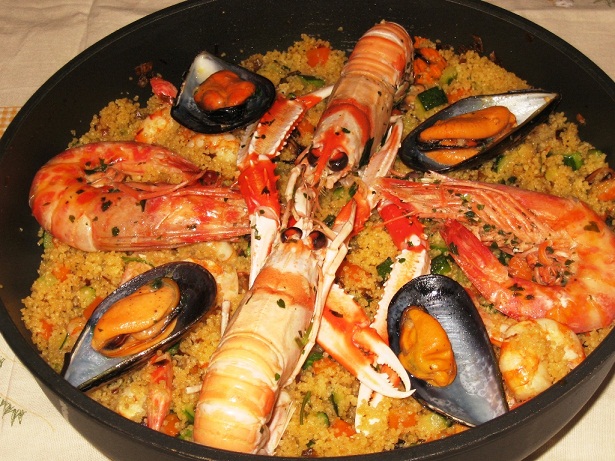

The cuisine of Trapani, is one of the most famous of Sicily.
Full of tasty Sicilian processing common to the classical repertoire, but special arrangements made with entirely original such as couscous.
The Sicilian cuisine has been influenced in a decisive way by the different dominations that have occurred over time, eventually, have played a decisive also in the island┤s cuisine.
The couscous, food consists of grains of semolina steamed, typical of North Africa (Arabic means Kuskusu chopped into small pieces) is one of many cases.
The typical couscous Trapani provides only a condiment with fish.
The original version of couscous requires, in addition to the semolina grain Goss, special tools, including the "mafaradda" (it is a special container of terracotta painted walls curved and flat bottom, where the grains of semolina are linked) and cuscusiera, or the "pot of c¨scu-on" (which is a kind of painted clay pot with many holes).
Traditional procedure
Obtain 500 grams of coarse semolina, a "mafaradda" (which is a special clay pot painted with a flat bottom and flared edges) and a "lemma" (is another clay pot painted with flaring that may already contain the bran worked).
Place in a bowl of water and salt (5 grams of salt per 100 cc of water). At this point, proceed to ┤"incocciatina".
Place in "mafaradda" alongside a handful of meal and a tablespoon of salt water, then continue with rotational movements of the fingers so as to absorb water to the semolina and at the same time, forming the grains will file in the "lemma" . Continue until all the semolina.
Add the semolina "incocciata" a wire jar virgin olive oil and, with the palms of your hands, rub it so that, eventually, all the grains are shelled and well oiled.
Before cooking, spend two words on the pot to cook the couscous:
The traditional pot for couscous ("cuscusiera") used in Trapani, is composed of a sort of colander earthenware painted with a flat bottom, with its cover and a high-sided pan that can accommodate the cuscusiera. There are other pots (French) which reflect the traditional pots but made of steel or aluminum where the "cuscusiera" is embedded directly into the pot that will hold the cooking water. For those who do not possess these tools just find a pot of the same characteristics and a suitable strainer.
At this point, after choosing the pot and the sauce (in our case for fish broth) proceed to the steaming couscous.
Fill three-quarters of the pot with water, where we have added a little olive oil (used to keep the boiling water is not excessive); reclining above "cuscusiera" and prepare the "cuddura" (this step is avoided if you have a pot to the French). With the mixture of flour and water, we get a compound that allows us to seal the point of union between the pot and the "cuscusiera" so that the steam comes out only by cuscusiera.
At this point you have 4:00 to 5:00 at the bottom of the bay leaves "cuscusiera" and arrange over the couscous. Drill holes in the couscous, aiutantovi with the handle of a wooden spoon, which will act as a chimney for the steam leak. Cover and place the pot on the fire.
As soon as the steam comes out of the holes practiced in couscous, reduce heat and simmer for about two and a half hours.
At this stage, you have to mix the couscous from time to time (10-15 minutes) and enjoy all over again the holes as described above.
In the last part of cooking, mix a little ┤more often, repeating the process until completion of the cooking.
When the couscous is cooked, pour it into the "lemma", cover with fish stock and put it to rest, Cover and covered with a woolen cloth for half an hour.
Serve in serving dishes and sprinkling with more broth boneless pieces of fish thoroughly.
for more info:
http://www.ricettedisicilia.net/primi/cuscus-o-cous-cous-di-pesce-alla-trapanese/

Trapani Sud Sound Festival-PLANET FUNK
On 5 September, boat parties, DJ sets and tastings of typical local products are scheduled in the morning; in particular very inte...
29/07/2025 - dthbgn: https://community.octoprint.org/t/10-ways-to-speak-to-someone-at-holla...
***
29/07/2025 - dthbgn: https://www.purplepass.com/events/327249-carnival-cruise%C2%AE%EF%B8%8...
***
28/07/2025 - scsdac: 28/07/2025 - sdcvdv: 28/07/2025 - sdcvdv: ...
***
Via Sant'Andrea, 2 - 91100 Trapani
Tel. +39 380 471 7849 | Email: info@ababordo.it